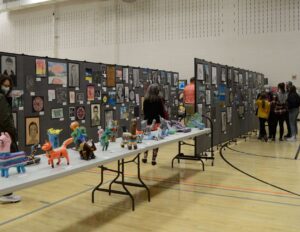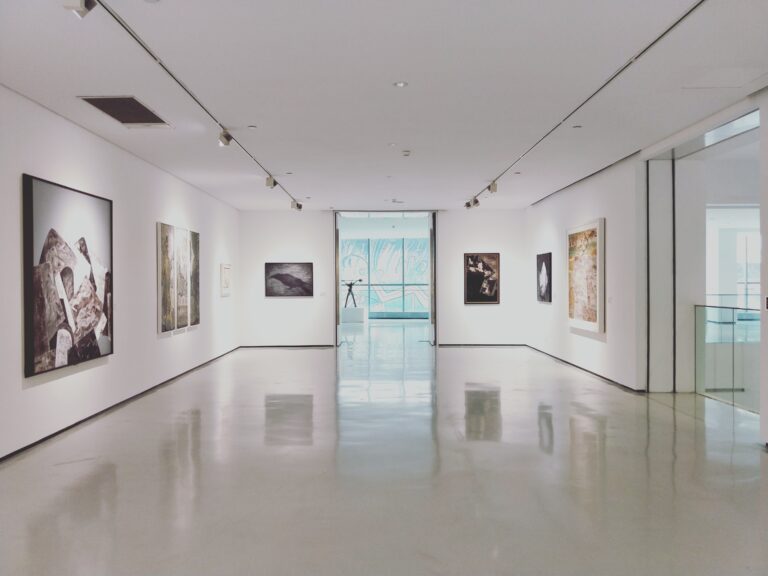Spring conjures up many images. Cherry blossoms, baby animals, longer days to name a few! For the art teacher spring conjures up Spring Showcases. Ahhh, only a school art show can both instill pleasure and pain at once. There is nothing like seeing all your students’ hard work on display to make you feel proud. At the same time, there is nothing like an art show to create stress as well.
So, while those mixed feelings may never go away completely, let me provide some thoughts, options, and guidance for your art show. There is a lot to a school art show so I’m breaking this post into Parts I and II. So, come back next week for more information on best practices for approaching and implementing a Spring Art Show.
Get everyone on the same page
If you are a new art teacher at a school, you may hear a lot of expectations to serve up the same art show that has been in existence for, well, what feels like an eternity at your school. It’s not a bad thing to know what has been done in the past, but unless an art show is in your contract, you can bring your own ideas to the plate. Maybe you run a lot of half-year art classes and two smaller showcases make sense, one for fall and one for spring. Maybe you want to simply do a senior showcase. Maybe you create a gallery space for ongoing student shows. Or maybe you join forces with all the art teachers in your district and have a large showcase of K-12 work every year or every other year. Whatever is selected, make sure you consider and advocate for what works for you and your art program. The earlier you have the conversation, the better prepared you can be.
It also helps to involve your students in plans as well. How do your dedicated art students feel about an art show and their place in it? In one school I taught, we hosted a “Senior Showcase” where our seniors who often took 3-4 years of art were given a display panel and some wall space to exhibit their best pieces. At another school where we held K-12 art shows the seniors were charged with helping and coming up with the annual art show’s name and logo. These were traditions that the seniors looked forward to immensely and the seniors saw it as their right of passage. If you have an art club or National Art Honor Society these groups can be instrumental in helping put up and take down the art show as well.
Some schools offer a stipend for an art teacher to coordinate an art show. Some schools also support art teachers by providing a sub for classes while the teacher is hanging the art show. These are all ideas to bring up and ask for when you are working with your school on planning an art show.
Location, location, location
Generally, everyone loves the idea of an art show. Where the art show can reside is a whole other can of worms as schools rarely have unused spaces waiting around unused. The cafeteria and gym are often possible locations. As those are shared spaces, my experience is these can be difficult to occupy for any length of time as they are in great demand. If you opt for these locations, you are likely to have a short time to hang the show and a short time for the community to enjoy it.
There is no magic answer for location but you do need to negotiate what works for your art program and sometimes put your creative thinking skills to work. I have heard of schools that have used local galleries or businesses, their school libraries, foyers, the art rooms themselves, superintendent’s offices, wall space all over the school, etc. Whatever you do, consider the integrity and dignity of the work. At one school, prior to my hiring, the exhibit was in the gym and they hung work on the volleyball net. For me, that didn’t feel tasteful. In time, we moved the event to the school lobby where we had some built-in display cases we could use for 3D work.
Size, location, show prep time, and length of the show are all very interconnected. You can’t have a large show if your available spaces aren’t large enough. If you want a large show and the only space big enough is the gym but the gym is needed for classes during the week and games on the weekend, that limits the length of time the show can be held and preparation time as well.
 Art Teacher Kathy Reed Brayle’s Art Show in the School gym.
Art Teacher Kathy Reed Brayle’s Art Show in the School gym.

 Angie Beckley Leming’s school art show in the school’s cafeteria.
Angie Beckley Leming’s school art show in the school’s cafeteria.
Consider your audience
You need an audience. You know that old adage, “If a tree falls in a forest, and there’s no one around to hear it, does it make a sound?” Well, is an artwork really shown if no one comes to see it? It’s disheartening to put a lot of work into an event without a good turnout. So, it’s common to piggyback on other events at school. For example, at my school, we held an art show in conjunction with the music’s winter and spring concerts. The music student performed and the audience mingled afterward with a reception in the foyer with the art show. We also left it up for about a week for the school to enjoy as well. Teachers were allowed to visit with their classes, faculty enjoyed looking at it during their prep period, and parents could also stop in at drop-off and pick-up times as well.
At the school I went to as a high schooler, art was on display for the Honor Society Induction. Another school did a show at the superintendent’s office. Sometimes schools exhibit art concurrent with a school play, parent’s night, etc.
Always consider the safety of the artwork as well, particularly 3D work that people may want to touch or might be jostled by energetic students. You know your school and student body, so make decisions keeping in mind what is reasonable to expect in terms of behavior towards artwork on display.
The role of technology
During Covid, many schools were forced to have shows digitally. While digitally may not be as gratifying as the in-person experience, it’s not always an all-or-nothing choice these days. You can run a virtual show concurrently, or even include a screen to share images of work that there wasn’t space to include or work is not available at exhibit time (like AP Studio Quality pieces being sent as part of the AP portfolio). See our previous article on the topic of digital art shows. Use your school and/or department’s social media channels to get the word out about the art show as well.
Come back next week for Part II with more wisdom on putting together your school art show. We are talking art panels, matting, mounting, tags, etc. The works!




